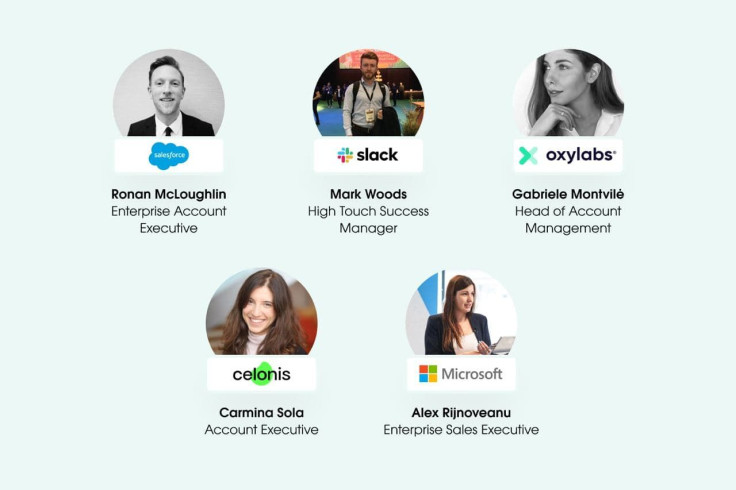Building Strategic Customer Relationships: Lessons From Leading Tech Industry Professionals

Business technology companies often try to get their customers excited about their new products, services, and associated features. However, a strategic approach to customer relationships is technologically agnostic - it’s simply about finding out how your product can help reach your customer’s vision or KPIs. This was the main message from a panel discussion “Strategic Account Management” hosted by Oxylabs, a leading public data-gathering solutions provider and joined by the representatives from Microsoft, Slack, Salesforce and Celonis.
The session aimed to identify key tips for working with strategic accounts - from planning the objectives to evaluating the overall progress. The speakers focused on managing and building relationships with large enterprise accounts - the ones that require the most attention and custom approach to account management. The discussion covered key account identification, strategic account planning, stakeholder analysis and quarterly business reviews.
Gabrielė Montvilė, Head of Account Management at Oxylabs and the host of the panel discussion, says that while different tech companies have different B2B account management processes and role titles, they all have a mutual goal to drive customer business value and as a result, grow their existing business partnerships. “We’ve therefore organized this knowledge sharing session allowing industry experts to exchange the strategic account management best practices and learn from each other.”
Choose your focus
According to Carmina Sola, the Account Executive at Celonis, the strategic account management process starts with identifying your key accounts.
“While there are obvious factors, like revenue or growth, we also consider where we, as a company, can offer a competitive advantage or industry expertise. For example, if we have been successful with an X company and have built a good case, we will be looking to work with the highest growth companies in that specific industry”, - said Carmina.
Another factor to consider when identifying key accounts - access to the C-level executives and key business decision-makers. According to Carmina, to form strategic partnerships, it’s important to have C-suite conversations. Meanwhile, Ronan McLoughlin, Enterprise Account Executive at Salesforce concluded that in fact, you can only identify an account as strategic, if you have connections at this level. He also encouraged not to forget to build connections with other stakeholders and lower management too - they will be able to provide much more specific information and act as internal champions.
Plan strategically
“When you start with strategic account planning, make sure you do your research and read anything you can find about the company. But then, also talk to as many people as possible, top-down and bottom-up”, advised Ronan.
His other key advice on account planning is making a team working with that customer as excited about it as he is. To do that, Ronan has built an interactive account plan, providing everyone from the account team a common understanding of what the customer is trying to achieve and what progress we have made so far. He also organizes weekly catch-ups with anyone involved with that key account.
“Everything has to align with the vision and goals the customer has outlined in their annual report, otherwise we won't be hitting the mark. Therefore, we need to make sure we are all singing from the same hymn sheet”, - Ronan said.
Aim for joint success
Mark Woods, High Touch Success Manager at Slack, shared one more tip to make sure your plan is aligned with the customer’s vision. He makes his key account plans fully transparent and shares them with the customer:
“Account plans need customer buy-in, it wouldn’t work otherwise. This is why we create joint success plans with our high-priority customers where we work on that value map together”, - Mark said.
Speak the industry language
Aligning with the vision of the customer also means speaking their language, stressed Alex Rijnoveanu, Enterprise Sales Executive, at Microsoft: “It doesn’t work when we have technology-focused perspective and simply present a newly launched AI-driven feature. It has to be really focused on their strategy and targets - only afterward you can move on to the solution demonstration.”
According to Alex, there are several global issues and trends that are relevant to almost every business nowadays, such as accessibility, data protection, sustainability, climate change etc. These topics can be a great conversation starter and not only help you connect to your customer’s vision, but also position your products more effectively as a result.
Keep building trust during business reviews
The last process of the strategic account management cycle - quarterly business reviews - is seen as an administrative burden by some. However, if it’s done right, it can create additional value both for the customer and the supplier.
Ronan McLoughlin from Salesforce shared that while some companies use quarterly business reviews to sell new features, the partnership benefits much more when sales step back in these sessions.
“We sometimes let our customer success team take the lead in these meetings and they talk only about the customer and their business. Knowing that the session will not be about sales, we pass the filter of the vendor managers - this way in some cases we managed to attract even the top-level management to such meetings, even if we weren’t able to access these people before.”
The panel discussion on strategic account management was part of the continuous Oxylabs efforts to ensure constant learning and knowledge exchange between technology sector leaders.
Oxylabs is a leading public data-gathering solutions provider. It is in trusted partnerships with dozens of Fortune 500 companies and global businesses, helping them unearth hidden gems of business intelligence data through state-of-the-art products and technological expertise.





















